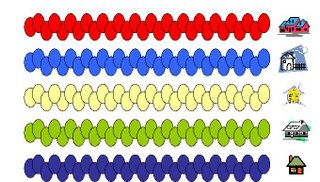 This is a game for younger learners which aims to consolidate the numbers 1-6 and the colours. For each group of children you will need : two dice – one with numbers and the other with colours; a counter for each child; and a playing board. The playing board should have the same colours as those on the dice and can be made easily using Word and clipart. If you don’t have a colour printer, you’ll need to leave the circles blank and then colour them by hand. The number of circles you use will depend on the age and attention span of the children. There are also various ways the game can be played – choose depending on which you think your learners would take to best.
This is a game for younger learners which aims to consolidate the numbers 1-6 and the colours. For each group of children you will need : two dice – one with numbers and the other with colours; a counter for each child; and a playing board. The playing board should have the same colours as those on the dice and can be made easily using Word and clipart. If you don’t have a colour printer, you’ll need to leave the circles blank and then colour them by hand. The number of circles you use will depend on the age and attention span of the children. There are also various ways the game can be played – choose depending on which you think your learners would take to best.Version One :The players start with their counters on the circle furthest from the house. Each child in turn throws the colour dice and says the colour. If it’s the same as the colour of their “path”, they throw the number dice and move their counter forward the same number of circles. The first one to reach their house is the winner.
Version Two : The first player throws the dice, but this time the player on his/her left calls the colour and the number. If either of those two players has the correct colour, s/he moves her counter the appropriate number of places. This speeds the game up a bit, as there’s a one in three chance of someone moving, instead of only one in six.
Version Three : In each group one child is the dicemaster but does not play. The dicemaster throws the dice and calls the colour and number that come up. The player with that colour moves their counter forward the appropriate number of circles. At the end, the winner becomes the dicemaster, and the old dicemaster joins the game. This makes the game much faster, as someone moves on each throw.
 The problem with any game like this is that it’s quite possible to play without saying anything – which defeats the object of the activity in an EFL classroom. One way of getting round this with Version Three is if the dicemaster throws the dice behind a barrier (such as a large book) which prevents the group from seeing the result – that way they have to listen to what s/he says. Another possibility, is if the teacher throws the dice and calls the colour and numbers to the whole class. Obviously, in this case there will be a winner in each group at the same moment. This only consolidates the children’s receptive knowledge of the language, but is sometimes a good way of introducing Version Three and making sure the children understand the game before they continue playing in groups.
The problem with any game like this is that it’s quite possible to play without saying anything – which defeats the object of the activity in an EFL classroom. One way of getting round this with Version Three is if the dicemaster throws the dice behind a barrier (such as a large book) which prevents the group from seeing the result – that way they have to listen to what s/he says. Another possibility, is if the teacher throws the dice and calls the colour and numbers to the whole class. Obviously, in this case there will be a winner in each group at the same moment. This only consolidates the children’s receptive knowledge of the language, but is sometimes a good way of introducing Version Three and making sure the children understand the game before they continue playing in groups. Further Reading ...
No comments:
Post a Comment